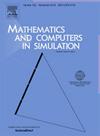具有莱维噪声和时变系数的多维随机动力系统的福克-普朗克方程和费曼-卡克公式
IF 4.4
2区 数学
Q1 COMPUTER SCIENCE, INTERDISCIPLINARY APPLICATIONS
引用次数: 0
摘要
本文的目的是为一类由乘法对称(或非对称)α-稳定莱维噪声驱动的时变随机微分方程建立一个费曼-卡克公式版本的时变多维非局部福克-普朗克方程。首先,通过邻接算子法推导出了前向非局部福克-普朗克方程,克服了与时间相关的多维非线性对称 α 稳定莱维噪声所带来的挑战。随后,通过应用后向非局部福克-普朗克方程的技术,建立了前向多维时变非局部福克-普朗克方程的费曼-卡克公式,该公式与乘法对称α稳定莱维噪声驱动的后向随机微分方程相关联。值得注意的是,在非对称 α 稳定莱维噪声情况下,非局部算子中特征函数的存在增加了分析的复杂性。利用费曼-卡克公式,可以证明前向非局部福克-普朗克方程的解可以很容易地通过蒙特卡罗近似来模拟,特别是在涉及大步长时模拟设置的情况下。通过有趣的例子说明了这些概念,并研究了与随机 SIS 模型和 MeKS 网络随机模型(反映 MecA 复合体、ComK 和 ComS 之间的相互作用)相对应的概率密度函数在较长时间内的动态演化。本文章由计算机程序翻译,如有差异,请以英文原文为准。
Fokker–Planck equation and Feynman–Kac formula for multidimensional stochastic dynamical systems with Lévy noises and time-dependent coefficients
The aim of this paper is to establish a version of the Feynman–Kac formula for the time-dependent multidimensional nonlocal Fokker–Planck equation corresponding to a class of time-dependent stochastic differential equations driven by multiplicative symmetric (or asymmetric) -stable Lévy noise. First the forward nonlocal Fokker–Planck equation is derived by the adjoint operator method, overcoming the challenges posed by time-dependent multidimensional nonlinear symmetric -stable Lévy noise. Subsequently, the Feynman–Kac formula for the forward multidimensional time-dependent nonlocal Fokker–Planck equation is established by applying techniques for the backward nonlocal Fokker–Planck equations, which is associated with the backward stochastic differential equation driven by the multiplicative symmetric -stable Lévy noise. Notably, in the case of asymmetric -stable Lévy noise case, the presence of the characteristic function in the nonlocal operator adds complexity to the analysis. Using the Feynman–Kac formula, it is demonstrated that the solution of the forward nonlocal Fokker–Planck equation can be readily simulated through Monte Carlo approximation, especially in scenarios involving long-time simulation settings with large steps. These concepts are illustrated with intriguing examples, and the dynamic evolution of the probability density function corresponding to the stochastic SIS model and the stochastic model for the MeKS network (reflecting the interactions among the MecA complex, ComK and ComS) are investigated over an extended period.
求助全文
通过发布文献求助,成功后即可免费获取论文全文。
去求助
来源期刊

Mathematics and Computers in Simulation
数学-计算机:跨学科应用
CiteScore
8.90
自引率
4.30%
发文量
335
审稿时长
54 days
期刊介绍:
The aim of the journal is to provide an international forum for the dissemination of up-to-date information in the fields of the mathematics and computers, in particular (but not exclusively) as they apply to the dynamics of systems, their simulation and scientific computation in general. Published material ranges from short, concise research papers to more general tutorial articles.
Mathematics and Computers in Simulation, published monthly, is the official organ of IMACS, the International Association for Mathematics and Computers in Simulation (Formerly AICA). This Association, founded in 1955 and legally incorporated in 1956 is a member of FIACC (the Five International Associations Coordinating Committee), together with IFIP, IFAV, IFORS and IMEKO.
Topics covered by the journal include mathematical tools in:
•The foundations of systems modelling
•Numerical analysis and the development of algorithms for simulation
They also include considerations about computer hardware for simulation and about special software and compilers.
The journal also publishes articles concerned with specific applications of modelling and simulation in science and engineering, with relevant applied mathematics, the general philosophy of systems simulation, and their impact on disciplinary and interdisciplinary research.
The journal includes a Book Review section -- and a "News on IMACS" section that contains a Calendar of future Conferences/Events and other information about the Association.
 求助内容:
求助内容: 应助结果提醒方式:
应助结果提醒方式:


